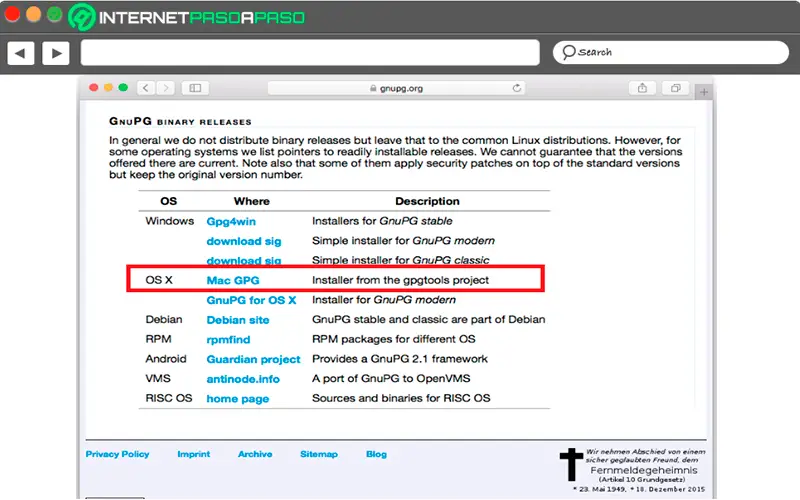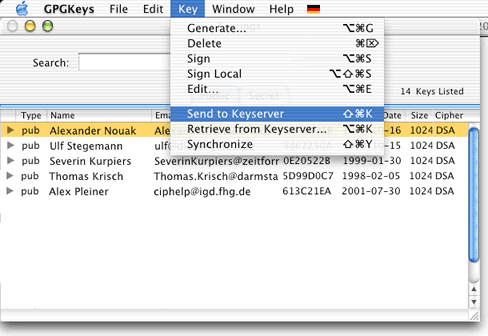
- #Gnupg mac how to#
- #Gnupg mac install#
- #Gnupg mac portable#
- #Gnupg mac software#
- #Gnupg mac password#
To upload a key you’ve already generated, open GPG Keychain Access, click on the “Secret” tab, and click on the key you’d like to upload. GPG Keychain Access provides a way to automate uploading your key to a keyserver. They provide a place to store a public key in such a way that others can easily retrieve it and add it to their keychains. So that’s where public keyservers come in. You can also post a public key to your Web site, but that presupposes that you have a Web site and that it is completely secure. A public key in ASCII format takes up over a thousand random characters, so it’s not something you want to type in by hand or repeat back to a colleague over the phone. Internet Keyserversĭistributing keys can be a challenge. Finally, GPG Keychain Access offers a way to find keys over the Internet using public keyservers. You can also use GPG Keychain Access to export your public key into a format others can use to add it to their own GnuPG keychain. Your collection of keys, including the public keys of others and your own secret keys, is called a keychain. With it you can create keys, collect public keys from your correspondents, and search public key servers to add to your collection of public keys from others. Managing your keys is a job for the GPG Keychain Access app. In fact, to use GnuPG encryption successfully, anybody you’re going to be sharing encrypted mail with has to have a copy of that key.
#Gnupg mac portable#
Some people keep theirs stored on a portable USB drive. No matter how strong the password, you should also take care to avoid making the key publicly available.
#Gnupg mac password#
The Mac Password Generator can help you with that. When you generate it, you can give it a password and that password should be a strong one. The secret key needs to be closely held.Whenever you generate a GnuPG keypair, you’re creating one of each: Sharing and Managing KeysĪt the core of GnuPG’s capability to secure your messages and files or verify the integrity of messages you sign with it is the concept of public and secret keys.

#Gnupg mac software#
We’re going to start from the assumption that you’ve installed all the software and have generated a GnuPG key. Part two spent time installing and configuring GPGMail.
#Gnupg mac how to#
If you need a refresher on GnuPG, or want more detailed guides on installation, part one of these columns covered what public-key cryptography is and how to get MacGPG.

#Gnupg mac install#
You’ll also want to go ahead and install GPGMail, a plugin that works with Apple’s Mail.app and provides a means to sign and encrypt e-mail messages. First, you’ll want to install MacGPG from the MacGPG site, including the files labeled “GNU Privacy Guard” and “GPG Keychain Access.” You’ll need a few things installed to follow along. This week, we’re going to delve into managing your GnuPG keys … the foundation of its security. Over the past few editions of Networking Notes, we’ve covered the installation and configuration of GnuPG, a Free Software implementation of Pretty Good Privacy, a public-key cryptography protocol you can use to secure your mail and text. Hopefully I'll have a more interesting post next week, this week has just been insane for me.We conclude our look at using public-key cryptography to secure your mail and text by delving into managing your GnuPG keys - the foundation of its security. You should be prompted to type in your password and check the box to store it in your keychain. That's it! After sourcing your bashrc or zshrc ( source ~/.zshrc) or restarting your terminal, run a git commit. Paste these lines: if test -f ~/.gnupg/.gpg-agent-info -a -n "$(pgrep gpg-agent)" thenĮval $(gpg-agent -daemon -write-env-file ~/.gnupg/.gpg-agent-info) Vi ~/.profile # or other file that is sourced every time Pinentry-program /usr/local/bin/pinentry-mac You just have to setup pinentry so that you wont have to type your password on every commit. After running the above commands, git will sign commits with your key. Git config -global user.signingkey KEY_ID

If you're confused about finding your key id, check step 11.Ĭopy the output from above and add it to GitHub With that being said, get started by having homebrew installed, and we'll go from there. I've followed a couple different guides across multiple computers to end up with a combination of them in this guide. Even if you follow the simple steps to generate one and let git know about it, you're going to be stuck typing a password on every commit if you don't setup an agent to handle adding it to your keychain for you. Setting up gpg keys can be a little annoying. The second reason is because you're reading this article! If you're not famous and aren't verified on Twitter, this feels almost as cool. I know you want to have a verified badge like this next to your commits on github.


 0 kommentar(er)
0 kommentar(er)
